Advertisements
Chapters
2: Polynomials
3: Coordinate Geometry
4: Linear Equation In Two Variables
▶ 5: Introduction To Euclid's Geometry
6: Lines & Angles
7: Triangles
8: Quadrilaterals
9: Areas of Parallelograms & Triangles
10: Circles
11: Construction
12: Heron's Formula
13: Surface Area & Volumes
14: Statistics & Probability
![NCERT Exemplar solutions for Mathematics [English] Class 9 chapter 5 - Introduction To Euclid's Geometry NCERT Exemplar solutions for Mathematics [English] Class 9 chapter 5 - Introduction To Euclid's Geometry - Shaalaa.com](/images/mathematics-english-class-9_6:5f2b1b2038084cf381bfa42c826a928c.jpg)
Advertisements
Solutions for Chapter 5: Introduction To Euclid's Geometry
Below listed, you can find solutions for Chapter 5 of CBSE NCERT Exemplar for Mathematics [English] Class 9.
NCERT Exemplar solutions for Mathematics [English] Class 9 5 Introduction To Euclid's Geometry Exercise 5.1 [Pages 46 - 47]
Choose the correct alternative:
The three steps from solids to points are ______.
Solids - surfaces - lines - points
Solids - lines - surfaces - points
Lines - points - surfaces - solids
Lines - surfaces - points - solids
The number of dimensions, a solid has ______.
1
2
3
0
The number of dimensions, a surface has ______.
1
2
3
0
The number of dimension, a point has ______.
0
1
2
3
Euclid divided his famous treatise “The Elements” into ______.
13 chapters
12 chapters
11 chapters
9 chapters
The total number of propositions in the Elements are ______.
465
460
13
55
Boundaries of solids are ______.
surfaces
curves
lines
points
Boundaries of surfaces are ______.
surfaces
curves
lines
points
In Indus Valley Civilisation (about 3000 B.C.), the bricks used for construction work were having dimensions in the ratio ______.
1 : 3 : 4
4 : 2 : 1
4 : 4 : 1
4 : 3 : 2
A pyramid is a solid figure, the base of which is ______.
only a triangle
only a square
only a rectangle
any polygon
The side faces of a pyramid are ______.
Triangles
Squares
Polygons
Trapeziums
It is known that if x + y = 10 then x + y + z = 10 + z. The Euclid’s axiom that illustrates this statement is ______.
First Axiom
Second Axiom
Third Axiom
Fourth Axiom
In ancient India, the shapes of altars used for household rituals were ______.
Squares and circles
Triangles and rectangles
Trapeziums and pyramids
Rectangles and squares
The number of interwoven isosceles triangles in Sriyantra (in the Atharvaveda) is ______.
Seven
Eight
Nine
Eleven
Greek’s emphasised on ______.
Inductive reasoning
Deductive reasoning
Both A and B
Practical use of geometry
In Ancient India, Altars with combination of shapes like rectangles, triangles and trapeziums were used for ______.
Public worship
Household rituals
Both A and B
None of A, B, C
Euclid belongs to the country ______.
Babylonia
Egypt
Greece
India
Thales belongs to the country ______.
Babylonia
Egypt
Greece
Rome
Pythagoras was a student of ______.
Thales
Euclid
Both A and B
Archimedes
Which of the following needs a proof?
Theorem
Axiom
Definition
Postulate
Euclid stated that all right angles are equal to each other in the form of ______.
an axiom
a definition
a postulate
a proof
‘Lines are parallel, if they do not intersect’ is stated in the form of ______.
an axiom
a definition
a postulate
a proof
NCERT Exemplar solutions for Mathematics [English] Class 9 5 Introduction To Euclid's Geometry Exercise 5.2 [Pages 48 - 49]
State whether the following statement is True or False:
Euclidean geometry is valid only for curved surfaces.
True
False
The boundaries of the solids are curves.
True
False
The edges of a surface are curves.
True
False
The things which are double of the same thing are equal to one another.
True
False
If a quantity B is a part of another quantity A, then A can be written as the sum of B and some third quantity C.
True
False
The statements that are proved are called axioms.
True
False
“For every line l and for every point P not lying on a given line l, there exists a unique line m passing through P and parallel to l ” is known as Playfair’s axiom.
True
False
Two distinct intersecting lines cannot be parallel to the same line.
True
False
Attempts to prove Euclid’s fifth postulate using the other postulates and axioms led to the discovery of several other geometries.
True
False
NCERT Exemplar solutions for Mathematics [English] Class 9 5 Introduction To Euclid's Geometry Exercise 5.3 [Pages 50 - 52]
Solve the following question using appropriate Euclid’s axiom:
Two salesmen make equal sales during the month of August. In September, each salesman doubles his sale of the month of August. Compare their sales in September.
Solve the following question using appropriate Euclid’s axiom:
It is known that x + y = 10 and that x = z. Show that z + y = 10?
Solve the following question using appropriate Euclid’s axiom:
Look at the figure. Show that length AH > sum of lengths of AB + BC + CD.

Solve the following question using appropriate Euclid’s axiom:
In the following figure, we have AB = BC, BX = BY. Show that AX = CY.
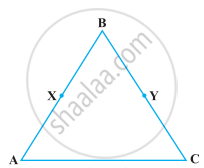
Solve the following question using appropriate Euclid’s axiom:
In the following figure, we have X and Y are the mid-points of AC and BC and AX = CY. Show that AC = BC.
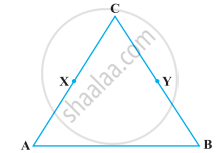
Solve the following question using appropriate Euclid’s axiom:
In the following figure, we have BX = `1/2` AB, BY = `1/2` BC and AB = BC. Show that BX = BY.
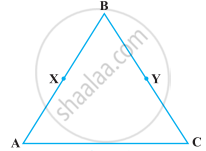
Solve the following question using appropriate Euclid’s axiom:
In the following figure, we have ∠1 = ∠2, ∠2 = ∠3. Show that ∠1 = ∠3.

Solve the following question using appropriate Euclid’s axiom:
In the following figure, we have ∠1 = ∠3 and ∠2 = ∠4. Show that ∠A = ∠C.

Solve the following question using appropriate Euclid’s axiom:
In the following figure, we have ∠ABC = ∠ACB, ∠3 = ∠4. Show that ∠1 = ∠2.

Solve the following question using appropriate Euclid’s axiom:
In the following figure, we have AC = DC, CB = CE. Show that AB = DE.
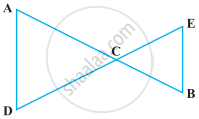
Solve the following question using appropriate Euclid’s axiom:
In the following figure, if OX = `1/2` XY, PX = `1/2` XZ and OX = PX, show that XY = XZ.
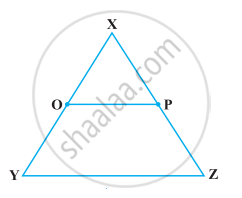
In the following figure AB = BC, M is the mid-point of AB and N is the mid-point of BC. Show that AM = NC.
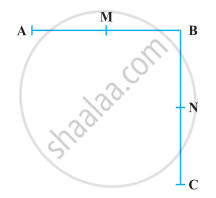
In the following figure BM = BN, M is the mid-point of AB and N is the mid-point of BC. Show that AB = BC.

NCERT Exemplar solutions for Mathematics [English] Class 9 5 Introduction To Euclid's Geometry Exercise 5.4 [Pages 52 - 53]
Read the following statement :
An equilateral triangle is a polygon made up of three line segments out of which two line segments are equal to the third one and all its angles are 60° each.
Define the terms used in this definition which you feel necessary. Are there any undefined terms in this? Can you justify that all sides and all angles are equal in a equilateral triangle.
Study the following statement:
“Two intersecting lines cannot be perpendicular to the same line”.
Check whether it is an equivalent version to the Euclid’s fifth postulate.
[Hint: Identify the two intersecting lines l and m and the line n in the above statement.]
Read the following statements which are taken as axioms:
- If a transversal intersects two parallel lines, then corresponding angles are not necessarily equal.
- If a transversal intersect two parallel lines, then alternate interior angles are equal.
Is this system of axioms consistent? Justify your answer.
Read the following two statements which are taken as axioms:
- If two lines intersect each other, then the vertically opposite angles are not equal.
- If a ray stands on a line, then the sum of two adjacent angles so formed is equal to 180°.
Is this system of axioms consistent? Justify your answer.
Read the following axioms:
- Things which are equal to the same thing are equal to one another.
- If equals are added to equals, the wholes are equal.
- Things which are double of the same thing are equal to one another.
Check whether the given system of axioms is consistent or inconsistent.
Solutions for 5: Introduction To Euclid's Geometry
![NCERT Exemplar solutions for Mathematics [English] Class 9 chapter 5 - Introduction To Euclid's Geometry NCERT Exemplar solutions for Mathematics [English] Class 9 chapter 5 - Introduction To Euclid's Geometry - Shaalaa.com](/images/mathematics-english-class-9_6:5f2b1b2038084cf381bfa42c826a928c.jpg)
NCERT Exemplar solutions for Mathematics [English] Class 9 chapter 5 - Introduction To Euclid's Geometry
Shaalaa.com has the CBSE Mathematics Mathematics [English] Class 9 CBSE solutions in a manner that help students grasp basic concepts better and faster. The detailed, step-by-step solutions will help you understand the concepts better and clarify any confusion. NCERT Exemplar solutions for Mathematics Mathematics [English] Class 9 CBSE 5 (Introduction To Euclid's Geometry) include all questions with answers and detailed explanations. This will clear students' doubts about questions and improve their application skills while preparing for board exams.
Further, we at Shaalaa.com provide such solutions so students can prepare for written exams. NCERT Exemplar textbook solutions can be a core help for self-study and provide excellent self-help guidance for students.
Concepts covered in Mathematics [English] Class 9 chapter 5 Introduction To Euclid's Geometry are Concept for Euclid’S Geometry, Euclid’S Definitions, Axioms and Postulates, Equivalent Versions of Euclid’S Fifth Postulate.
Using NCERT Exemplar Mathematics [English] Class 9 solutions Introduction To Euclid's Geometry exercise by students is an easy way to prepare for the exams, as they involve solutions arranged chapter-wise and also page-wise. The questions involved in NCERT Exemplar Solutions are essential questions that can be asked in the final exam. Maximum CBSE Mathematics [English] Class 9 students prefer NCERT Exemplar Textbook Solutions to score more in exams.
Get the free view of Chapter 5, Introduction To Euclid's Geometry Mathematics [English] Class 9 additional questions for Mathematics Mathematics [English] Class 9 CBSE, and you can use Shaalaa.com to keep it handy for your exam preparation.
